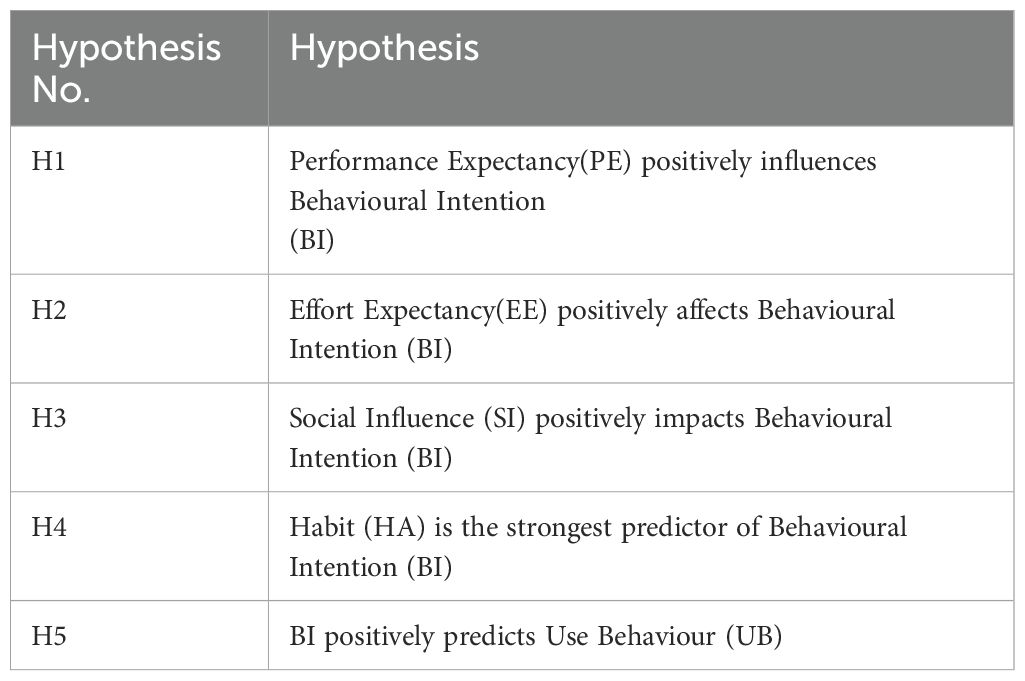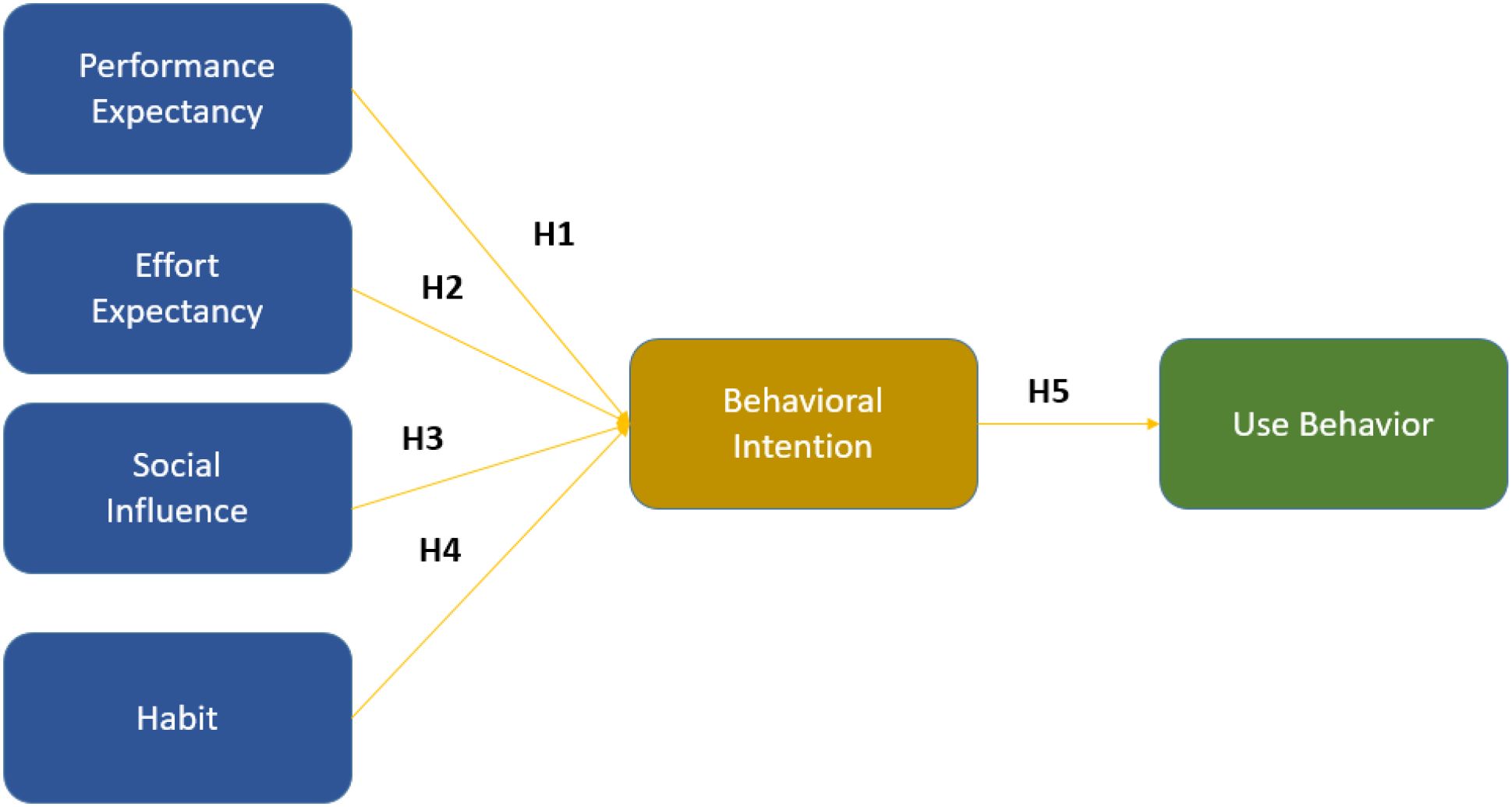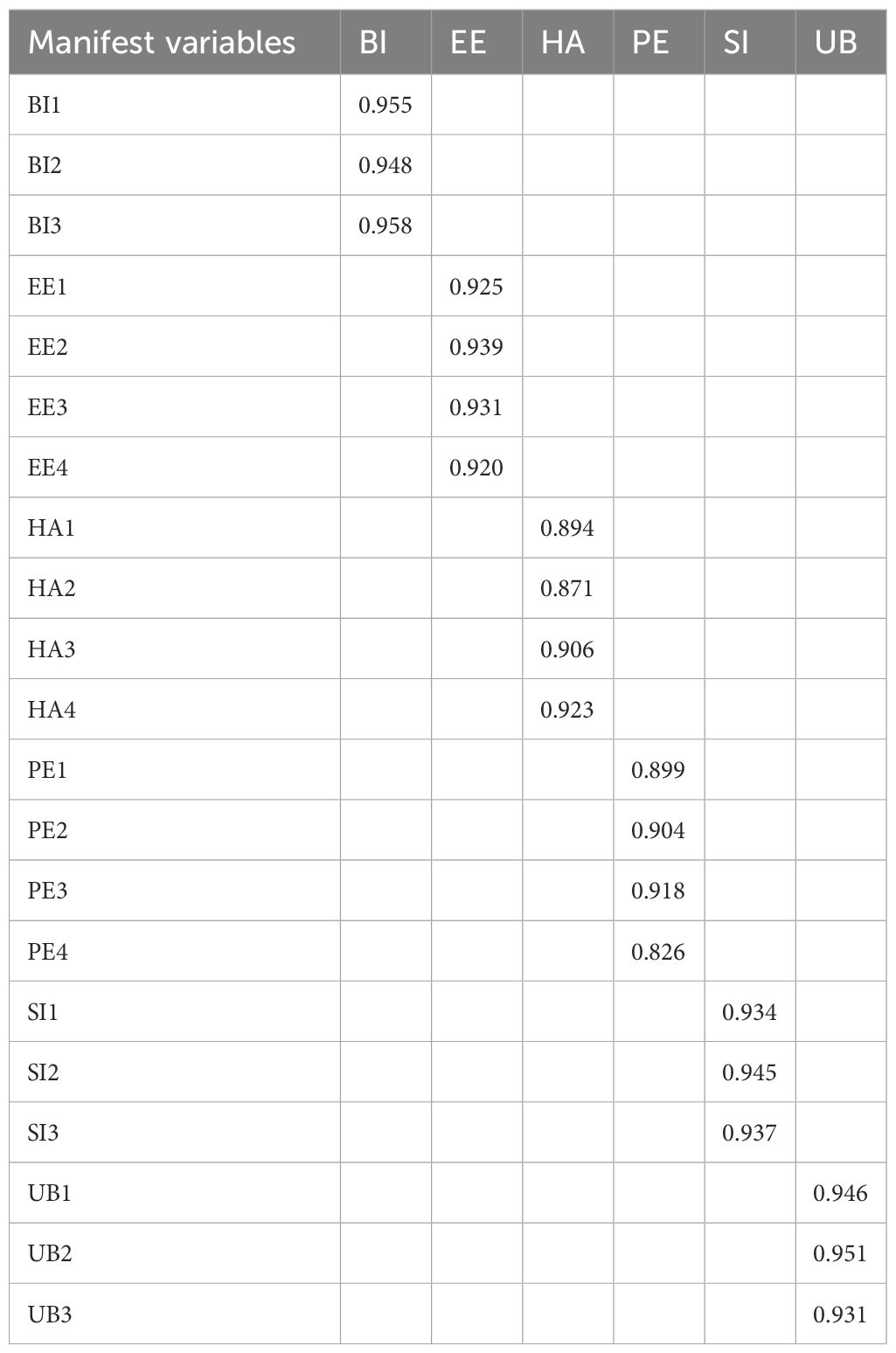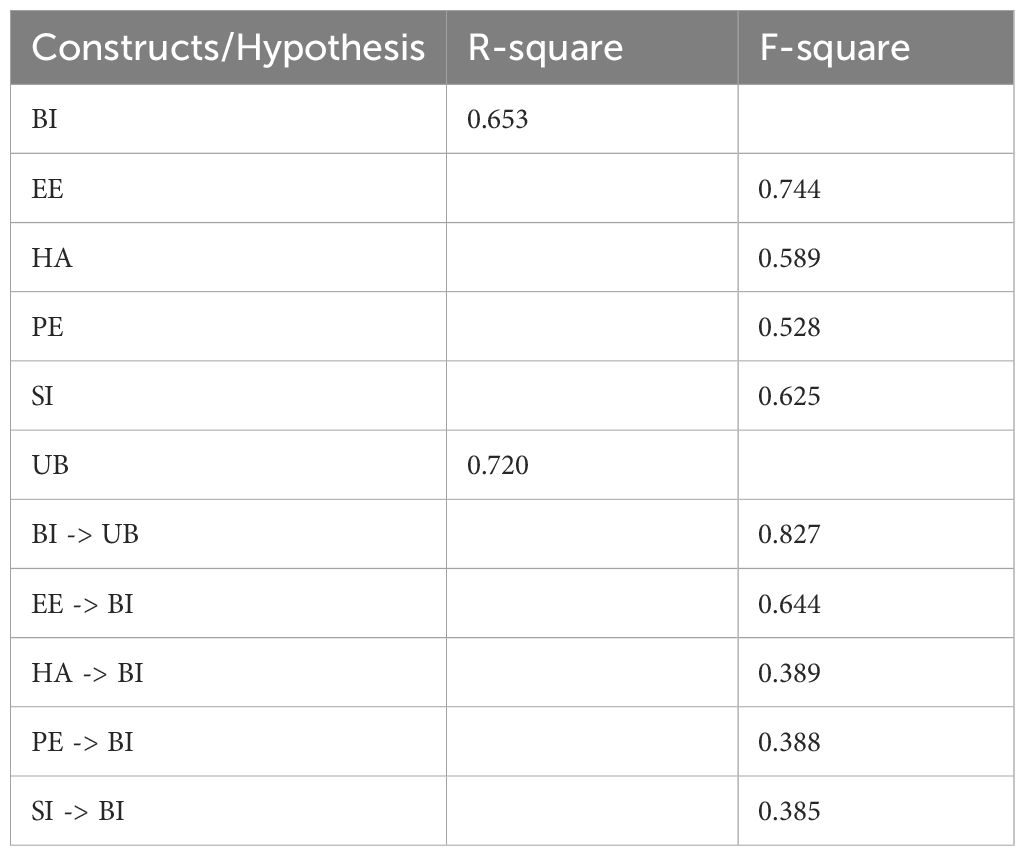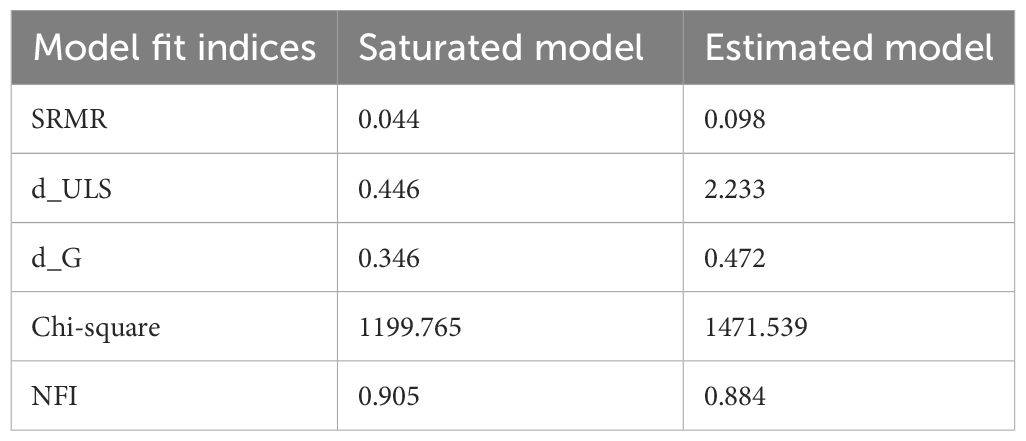- Transfer of Technology Unit, Indian Council of Agricultural Research (ICAR)- Central Institute for Research on Buffaloes, Hisar, Haryana, India
Sustainable livestock development hinges on the widespread adoption of scientific husbandry practices, particularly among smallholder farmers who are the backbone of rural animal agriculture. Despite increasing technological availability, the behavioural drivers that influence adoption remain insufficiently understood—creating a critical gap between innovation and impact. This study applies the Unified Theory of Acceptance and Use of Technology (UTAUT) and partial least squares structural equation modelling (PLS-SEM) to examine how habit (HA), performance expectancy (PE), effort expectancy (EE), and social influence (SI) shape behavioural intention (BI) and use behaviour (UB) among 530 buffalo farmers across India. Results show that habitual practices are the strongest predictor of behavioural intention (β = 0.420, p< 0.001), followed by effort expectancy (β = 0.206, p = 0.008) and performance expectancy (β = 0.156, p = 0.027). Social influence had no significant effect (β = 0.136, p = 0.133). These findings highlight that farmers prioritize compatibility with existing routines, ease of use, and visible benefits over peer or expert influence in adopting new practices. The study advances the literature on agricultural innovation by empirically validating habit as a central determinant of technology adoption in livestock systems. It offers practical insights for designing behaviourally responsive extension strategies that integrate innovations into the lived realities of farmers—thereby supporting more sustainable and scalable livestock development.
1 Introduction
Buffalo husbandry is fundamental to India’s agricultural economy, considerably enhancing national food security, rural livelihoods, and agricultural GDP. India possesses 56.8% of the global buffalo population, with 109.85 million buffaloes recorded in the 20th Livestock Census. These animals produce approximately 100 million tonnes of milk annually, which accounts for 55% of the nation’s total milk output. This production contributes ₹1.5 trillion, or 7.4% of the agricultural GDP, to the Indian economy (DAHD, 2024; 20th Livestock Census). The riverine buffalo (Bubalus bubalis) is vital in tropical climates, exhibiting enhanced susceptibility to heat, disease resistance, and feed conversion efficiency relative to exotic cattle breeds (Martínez-Burnes et al., 2024; Rout and Behera, 2021). In addition to milk production, buffaloes provide draught power and manure and function as living assets that boost financial resilience for 70 million smallholder households (Escarcha et al., 2020). The socioeconomic value of the sector is enhanced by its disproportionate influence on women’s empowerment; rural women account for 85% of buffalo management operations (Vijayalakshmy et al., 2023). This dual contribution—strengthening household income and enabling women’s economic participation—positions buffalo husbandry as a critical pathway for advancing Sustainable Development Goals, particularly SDG 1 (No Poverty), SDG 2 (Zero Hunger), and SDG 5 (Gender Equality), by combining economic viability with gender-inclusive and climate resilient livestock systems.
As of June 2025, the ICAR–National Bureau of Animal Genetic Resources (NBAGR) has officially recognized 20 registered buffalo breeds in India. These are broadly classified into five geographical groups: North (Murrah, Nili-Ravi, Gojri), West (Jaffarabadi, Mehsana, Surti, Banni), Central (Bhadawari, Chhattisgarhi, Nagpuri, Marathwadi, Pandharpuri, Dharwadi), East (Chilika, Kalahandi, Manda, Luit), and South (Toda, Bargur). Among them, the Murrah breed is considered the most prominent, predominantly reared in Haryana and Punjab. It is extensively utilized across the country due to its high milk yield, rich fat content, and remarkable adaptability to varied agro-climatic conditions. The adoption of scientific buffalo husbandry techniques offers a tested means to improve production, sustainability, and climate resilience. Studies show that using balanced feeding (Abebe et al., 2024), mineral supplementation (Gernand et al., 2016), and artificial insemination (AI) will boost milk yield by 42–58% while lowering methane emissions per litre by 18–22%. (Cardoso Consentini et al., 2021) While preventative healthcare measures can lower calf mortality from 23% to 9% (Wong et al., 2022), hygienic milking practices have been shown to reduce somatic cell counts by 65% and improve milk quality premiums by ₹3–5/litre (Vieira et al., 2021). Notwithstanding these apparent advantages, adoption of scientific management practices is shockingly low, with partial adoption for mineral supplementation and AI (Sharma, 2021; Dattatraya, 2024). Complicated behavioural barriers, including cognitive overload (Langer et al., 2024), habitual resistance (Ouellette and Wood, 1998), and mistrust in institutional advisories (Šūmane et al., 2018; Taylor and Van Grieken, 2015) that traditional extension approaches fail to address lead to this adoption paradox.
From Rogers’ (1962) Diffusion of Innovations, theoretical frameworks for technology adoption have developed into more complex models, such as the Unified Theory of Acceptance and Use of Technology (UTAUT) (Venkatesh et al., 2003). Although agricultural settings have benefited from the Technology Acceptance Model (TAM) (Davis et al., 1989) and Theory of Planned Behaviour (TPB), UTAUT’s thorough integration of performance expectancy, effort expectancy, social influence, and facilitating conditions offers better explanatory power (Rahi et al., 2019). Recent adaptations have included habit as a fifth construct, especially important for agricultural systems where routine procedures rule (Tamilmani et al., 2019). In agricultural settings, modified UTAUT frameworks have explained acceptance patterns for precision farming technologies (Nguyen et al., 2024; Larasati et al., 2024; Ronaghi and Forouharfar, 2020) and mobile-based advisory services (Kassem et al., 2021). The application of UTAUT remains conspicuously absent from the domain of livestock innovation, particularly in traditional systems such as buffalo husbandry. This omission is surprising given that buffalo farming in India is deeply embedded in socio-cultural routines, gendered labour patterns, and intergenerational practices—conditions that align well with UTAUT’s behavioural constructs. Moreover, buffalo husbandry entails both technological (e.g., scientific feeding, breeding, and healthcare) and behavioural innovations, where adoption is influenced not only by perceived utility but also by effort, habit, and social context. Therefore, this study represents a significant methodological advancement by applying UTAUT to a livestock based setting, offering empirical insights into how smallholder buffalo farmers perceive and adopt scientific husbandry practices. It demonstrates the model’s adaptability and emphasizes the importance of behaviourally informed frameworks in achieving sustainable livestock development. This study aims to solve several limits of previous studies on agricultural technology acceptance in India. First, most research uses binary adoption models—adopters against non-adopters—that miss the gradations and complexity of partial adoption (Nath et al., 2025; Seth et al., 2025; Feyissa et al., 2025). Second, the general emphasis on crop technologies—such as hybrid seeds or irrigation (Gaffney et al., 2016; Fadda et al., 2020)—has left a knowledge vacuum about innovations in livestock systems. Third, behavioural elements are sometimes studied separately without considering their relative importance or interacting effects (O’Donoghue et al., 2024). Fourth, the important function of habitual behaviours - which may be the most important obstacle to change in conventional livestock systems - is still mostly unexplored (Ouellette and Wood, 1998). Finally, few studies use strong theoretical models to examine the psychological processes guiding smallholder adoption choices methodically (Wauters and Mathijs, 2013; Singh et al., 2016). Our study aims to fill some research gaps by using a modified UTAUT framework to thoroughly examine behavioural elements influencing scientific buffalo husbandry adoption among Indian smallholders, We specifically want to investigate the relative relevance of performance expectancy, effort expectancy, social influence, and habitual practices in developing adoption intentions; also, we want to find context-specific barriers and facilitators that mediate these interactions; and finally, we want to create evidence based recommendations for developing more behaviourally-informed extension strategies.
2 Methodology
2.1 Sample and procedure
A purposive multistage sampling approach was adopted to ensure that the selected respondents were representative of the buffalo-rearing population in a region where buffalo husbandry plays a significant economic and cultural role. The state of Haryana was selected purposively for this study, given its national importance in buffalo-based dairy production. According to the Basic Animal Husbandry Statistics (Bahs and Mitchell, 2024), Haryana contributes to more than 80% of India’s buffalo milk output, making it an appropriate setting for studying behavioural drivers of scientific husbandry practices.
Four districts—Hisar, Rohtak, Jind, and Bhiwani—were chosen based on their prominence as breeding tracts of the Murrah buffalo, the most commercially significant breed in India (Sharma et al, 2023) Murrah accounts for approximately 42.8% of the registered buffalo population, known for its high milk yield, rich fat content, and adaptability across various agroecological zones (Bahs and Mitchell, 2024). These districts serve as the genetic and economic nucleus of Murrah buffalo development programs in India.
Within each selected district, two blocks were purposively identified based on buffalo population density, active dairy farming practices, and accessibility. The sample distribution across the blocks was as follows:
● Hisar district: Hisar block - 86 Agroha block – 59
● Jind district: Jind block - 83 Julana block – 53
● Bhiwani district: Bhiwani block -82 Bhiwani Khera block – 49
● Rohtak district: Rohtak block - 75 Meham block – 43
This resulted in a total sample of 530 buffalo farmers. While the study employed purposive sampling and does not claim statistical representativeness of the entire buffalo-farming population, the final sample was intentionally selected to reflect diversity in farm sizes, management practices, and production systems. This approach allowed for a meaningful exploration of behavioural adoption patterns across varying smallholder typologies.
Inclusion Criteria and Justification:
To ensure the quality and relevance of responses, the following inclusion criteria were applied:
1. ownership of at least one buffalo,
2. a minimum of one year of experience in buffalo husbandry, and
3. active involvement in dairy farming as a primary source of income.
These inclusion criteria were formulated to ensure that participants possessed practical, decision-making experience directly related to buffalo husbandry. Specifically, ownership of at least one buffalo and a minimum of one year of experience ensured that respondents were not seasonal or incidental livestock keepers, but were consistently engaged in buffalo management. The requirement that dairy farming be a primary source of income helped capture data from households where buffalo rearing had a significant economic bearing, thus enhancing the reliability of behavioural insights. Such purposive criteria align with the principle of “information-rich cases” in qualitative and mixed-method sampling strategies, where the goal is not generalization to the entire population, but depth of understanding from those most experienced with the phenomenon under study.
2.2 Research instrument
The study employed a structured interview schedule that was specifically designed to evaluate the adoption of scientific buffalo husbandry practices among smallholder farmers. This schedule included a face sheet for demographic information and a UTAUT-based interview schedule for behavioural analysis. The face sheet contained critical biographical information, such as the farmer’s age, gender, education level, livestock size, primary income source, and years of experience in buffalo rearing. This was succeeded by the primary interview schedule, which operationalized the UTAUT constructs through 24 meticulously crafted statements (Table 1) that were assessed on a five-point Likert scale (1 = strongly disagree to 5 = strongly agree). The instrument encompassed six critical dimensions: Performance Expectancy (PE), which evaluated the perceived advantages of practices such as hygienic milking and artificial insemination; Effort Expectancy (EE), which evaluated the ease of implementation for activities such as oestrus detection and vaccination scheduling; Social Influence (SI), which examined the impacts of peers and experts; Habit (HA), which documented routine practices such as mineral supplementation and the isolation of sick animals; Behavioural Intention (BI), which probed future adoption plans; and Use Behaviour (UB), which documented current practices such as organized milk marketing and the application of neem oil. The interview schedule was translated into local languages, exhaustively pretested with 30 farmers, and developed through expert consultations to ensure clarity and cultural appropriateness. Item randomization was implemented to reduce response bias. This exhaustive instrument facilitated the systematic collection of data while preserving a high level of ecological validity in the context of smallholder farming.

Table 1. Construct-wise manifest indicators with corresponding mean scores for adoption of scientific buffalo husbandry practices.
2.3 Measurement of constructs
In line with the Partial Least Squares Structural Equation Modelling (PLS-SEM) framework, the study conceptualized six constructs—Performance Expectancy (PE), Effort Expectancy (EE), Social Influence (SI), Habit (HA), Behavioural Intention (BI), and Use Behaviour (UB)—as latent variables. These latent constructs represent unobservable psychological or behavioural dimensions related to the adoption of scientific buffalo husbandry practices. Each construct was operationalized using a set of manifest indicators (statements) that are observable and measurable through the respondents’ self-reported agreement on a Likert scale. The measurement items for each construct were adapted and validated based on the Unified Theory of Acceptance and Use of Technology (UTAUT) and contextualized for the buffalo farming domain. Table 1 presents the construct-wise distribution of manifest indicators and their corresponding mean values.
Performance Expectancy (PE) was quantified using four statements that assessed farmers’ opinions of the advantages of scientific techniques. Effort Expectancy (EE) was assessed using four statements about the ease of implementation. Three statements about peer and expert pressures were used to measure social influence (SI). Habit (HA) was assessed using four statements that documented habitual activities. Behavioural
Intention (BI) was examined using three statements about adoption desire, and Use Behaviour (UB) was evaluated using four statements on current practice implementation.
2.4 Hypothesis testing
The study explored the relationships among the key constructs of 199 technology adoption, as outlined in the hypotheses presented in Table 2 and illustrated in Figure 1.
2.5 Data cleaning
All 530 interview schedules were comprehensively completed with no missing values. To identify multivariate outliers, Mahalanobis distance was computed using a p-value threshold of<0.001 based on the chi-square distribution and degrees of freedom equal to the number of independent variables. This analysis identified 12 significant outliers (2.3% of the sample), which were removed, resulting in a final sample size of 518. The exclusion of these outliers did not materially affect the structural relationships or the overall findings of the study.
Mahalanobis distance was computed to detect multivariate outliers using the formula:
where x is the observed data vector, μ is the mean vector, and S−1 is the inverse covariance matrix of the indicators. Distances were compared to the chi-square distribution threshold for p<0.001 with degrees of freedom equal to the number of indicators. Twelve responses exceeding the critical value were considered multivariate outliers and excluded, resulting in a final sample of 518.
2.6 Data analysis
The data were systematically organised in Microsoft Excel and subsequently analysed using Partial Least Squares – Structural Equation Modelling (PLS-SEM) through SMART PLS and R studio. PLS-SEM is a variance-based structural equation modelling approach selected for its effectiveness in analysing intricate relationships among various dependent and independent variables (Henseler et al., 2016).
Structural Equation Modelling (SEM) is a robust statistical technique widely used in the social and behavioural sciences to examine theoretical models involving latent constructs (Benitez and Balaguer, 2024). Partial Least Squares Path Modelling (PLS-PM), a variance-based SEM approach, offers several advantages over covariance-based SEM, such as lower sample size requirements, tolerance for non-normal data, and the flexibility to accommodate diverse measurement scales (Hair et al., 2019). Given these characteristics, PLS-PM is particularly recommended for exploratory research and predictive modelling, where the focus is on theory development and identifying key determinants, rather than on strict theory testing or model confirmation (Dufhues et al., 2021).The PLS-PM framework is comprised of two primary components:
1. Measurement (Outer) Model – Establishes the connections between latent variables (unobservable constructs, such as institutional features) and their manifest indicators (observed characteristics).
2. Structural (Inner) Model – Investigates the hypothesised causal pathways between latent variables (Jamil et al., 2012).
This method enables the efficient management of measurement errors while simultaneously facilitating an exhaustive evaluation of theoretical models (Hesari et al., 2020). By integrating both inner and outer models, PLS-SEM enables the identification of key variables and their interrelationships, thereby contributing to a more profound comprehension of the research framework (Abugre and Sackey, 2022).
3 Results
3.1 Assessment of the measurement model
The analysis was conducted in accordance with conventional two-stage structural equation modelling procedures. Initially, the reliability and validity of the measurement model were assessed to ensure that all constructs were adequately represented by their indicators. The hypothesised relationships between latent variables were tested by examining the structural model after the measurement properties were verified. In the subsequent sections, detailed statistical thresholds are reported, and both models exhibited satisfactory psychometric properties. The path coefficients were evaluated for statistical significance using bootstrapping.
3.1.1 Reliability
The internal consistency of the study was evaluated by Cronbach’s alpha and composite reliability (ρa and ρe) (Idowu et al., 2023). The Cronbach’s alpha values of all constructs exceeded the 0.70 threshold as given in Table 3, with Performance Expectancy (PE) at 0.909 and Behavioural Intention (BI) at 0.950 (Nunnally and Bernstein, 1994). The composite reliability indices confirmed the robustness of the measurement model, with ρa (0.910–0.950) and ρe (0.937–0.968) values surpassing the acceptable standard. The results presented in the table confirm the measurement model’s consistency in capturing latent components.

Table 3. Reliability and convergent validity metrics of latent constructs: Cronbach’s Alpha, composite reliability (ρa and ρe), and average variance extracted (AVE).
3.1.2 Convergent validity
Convergent validity was evaluated to confirm that the indicators theoretically associated with each construct exhibited a sufficient correlation (Ab Hamid et al., 2017; Hair et al., 2014) evaluated three criteria: (1) composite reliability (ρe) values ranged from 0.937 to 0.968, (2) all indicator factor loadings exceeded 0.70 (p< 0.001), and (3) average variance extracted (AVE) estimates ranged from 0.788 to 0.910, all of which exceeded the recommended thresholds of 0.70 for CR and 0.50 for AVE. The results, presented in the0 Table 2, confirm the robust convergent validity of the measurement model. This is because the indicators of each construct effectively converge on their corresponding latent variables.
3.1.3 Factor loadings
The measurement model demonstrated excellent indicator reliability, as all standardised factor loadings exceeded the recommended threshold of 0.50 (Hair et al., 2014) and established statistical significance (p< 0.001). The loadings, as shown in Table 4, were in the range of 0.826 (PE4) to 0.958 (BI3), suggesting that the latent constructs were strongly represented by respective manifest variables.
3.1.4 Average variance extracted
The measurement model exhibited excellent indicator reliability, with all standardised factor loadings surpassing the recommended criterion of 0.50 (Hair et al., 2014) and attaining statistical significance (p< 0.001). The loadings, as shown in Table 4, were in the range of 0.826 (PE4) to 0.958 (BI3), suggesting that respective manifest variables strongly represented the latent constructs.
3.1.5 Discriminant validity
Discriminant validity was evaluated to confirm that each latent construct was empirically distinct from the others in the model. In accordance with established guidelines (Hair et al., 2014), two criteria were assessed: (1) the Fornell-Larcker criterion, which stipulates that the square root of each construct’s AVE (diagonal values in Table 5) must exceed all interconstruct correlations (off-diagonal values), thereby confirming that constructs share more variance with their indicators than with other variables; and (2) cross-loading analysis, where all manifest variables exhibited more substantial loadings on their designated construct (>0.70) compared to any other construct (<0.50) (Table 6). The results collectively affirm the discriminant validity of the measurement model, indicating that the constructs assess distinct phenomena.
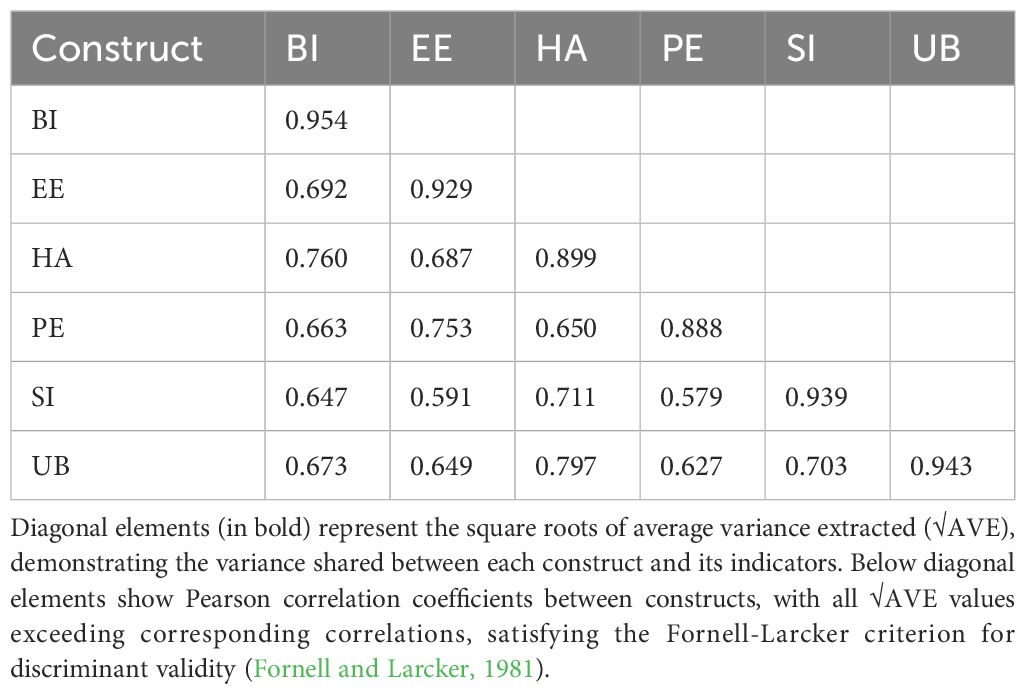
Table 5. Fornell-Larcker criterion evaluation: diagonal (√AVE) vs. off-diagonal (construct correlations).
To ensure robust discriminant validity, the Heterotrait-Monotrait (HTMT) ratio was calculated (Table 7), as it is now widely regarded as a more stringent and reliable measure than traditional criteria (Hair et al., 2019). All HTMT values presented in the table fall below the conservative threshold of 0.85, indicating that the latent constructs are empirically distinct from one another. The highest HTMT value, 0.797, occurs between Habit (HA) and Usage Behaviour (UB), suggesting a close but non-redundant relationship. This is theoretically coherent, as habitual behaviours often translate into actual usage, particularly in repetitive agricultural tasks. Despite this proximity, the value remains within acceptable bounds, confirming that the constructs measure related but separate facets of the adoption process.
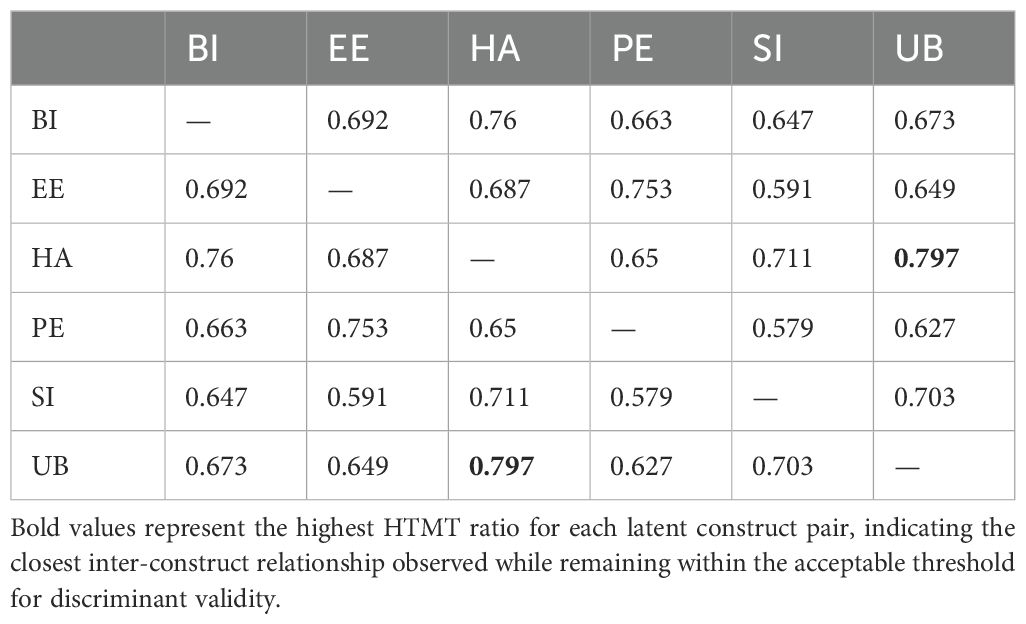
Table 7. Heterotrait-Monotrait Ratio (HTMT) matrix for discriminant validity assessment among latent constructs.
3.2 Structural model
The structural model was evaluated following confirmation of measurement model adequacy.
Path coefficients (β) quantify the relationships between latent constructs, with statistical significance (p< 0.05) determined through bootstrapping (5,000 samples). Standardized coefficients and corresponding t-values (in parentheses) are presented in Figures 2 and 3.
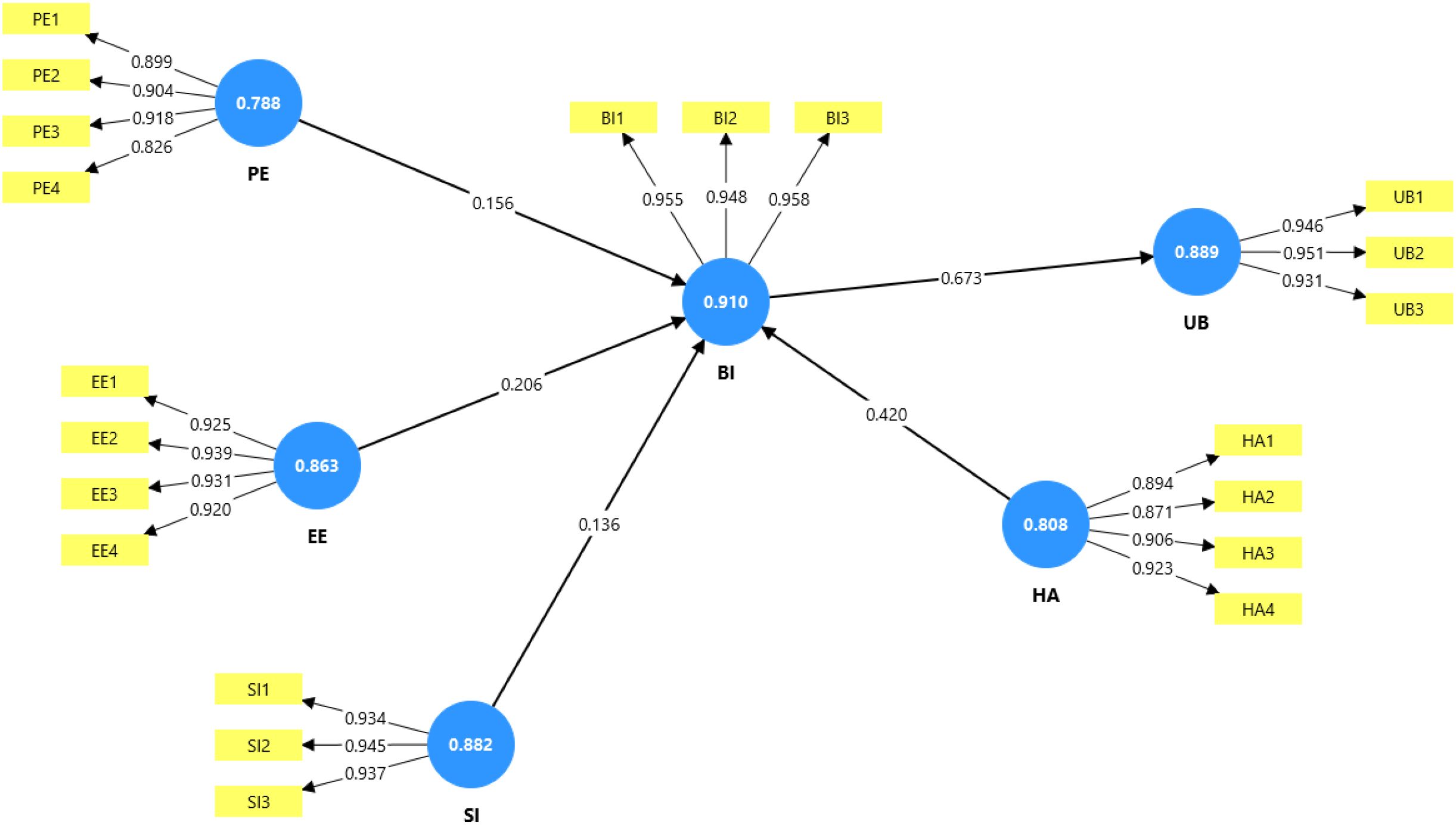
Figure 2. PLS-SEM depicting dnterrelations between latent and manifest variables with factor loadings, path coefficients, and composite reliability.
Model components:
➢ Latent variables (circles) with composite reliability (ρa) values.
➢ Manifest variables (rectangles) with standardized factor loadings.
➢ Path coefficients (β) for structural relationships between constructs.
Note: All estimates represent standardized values derived from PLS-SEM analysis.
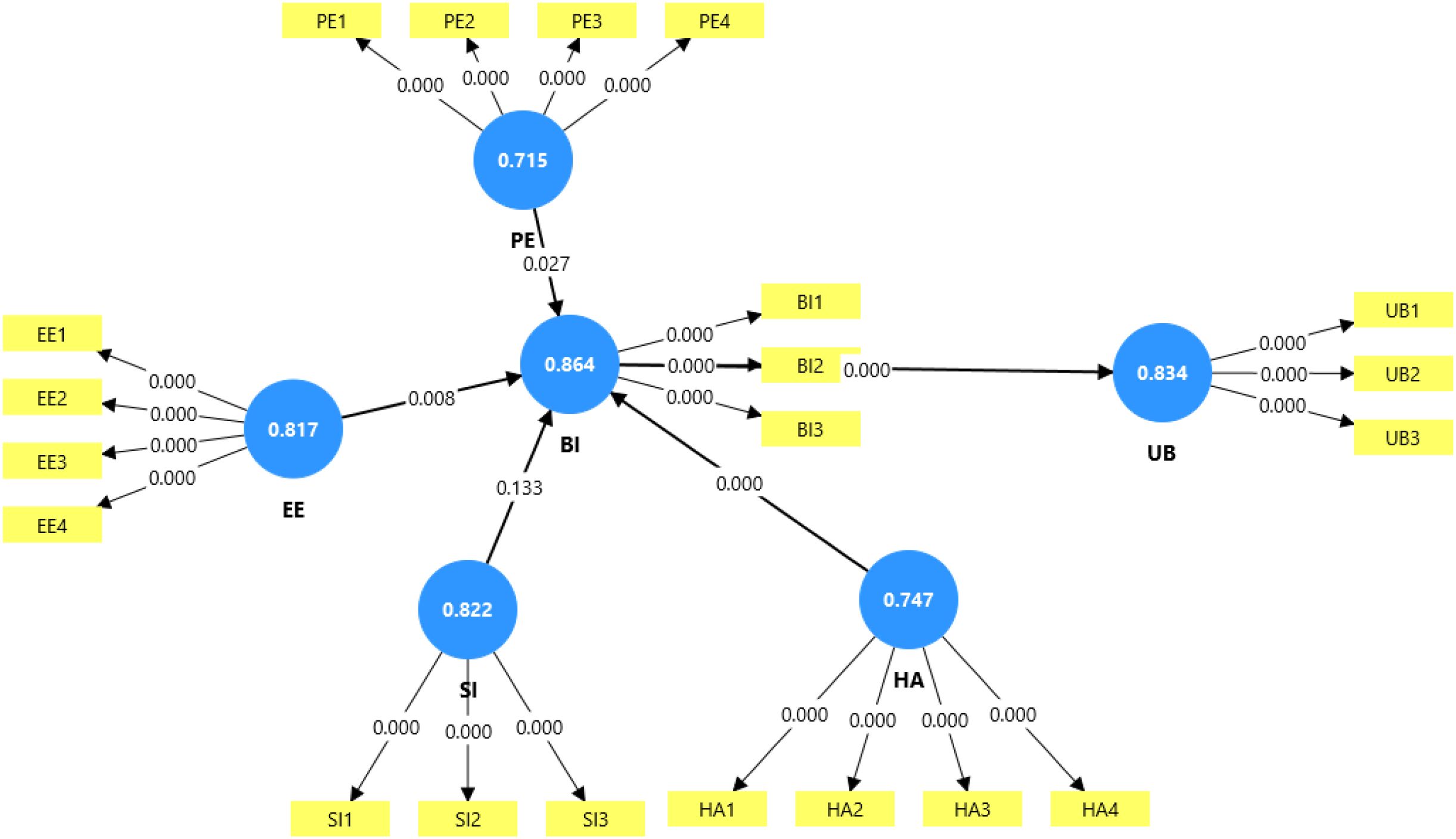
Figure 3. PLS-SEM depicting interrelations between latent and manifest variables with pvalues and composite reliability model specification:
• Latent variables: Represented by circles (composite reliability values shown)
• Manifest variables: Represented by rectangles
• Path coefficients: Arrow values indicate p-values for all relationships
Note: All p-values were derived from bootstrapping analysis (5,000 samples). Composite reliability values (ρc) demonstrate the internal consistency of each latent construct.
The analysis presents the path coefficients between constructs along with their 95% confidence intervals, estimated through a bootstrapping procedure with 5,000 resamples. As shown in Table 8, four of the five hypothesized direct relationships were statistically significant (p<

Table 8. Structural model assessment: path coefficients (β), standard errors, t-values, and p-values for hypothesized relationships.
0.05): behavioural intention significantly predicted use behaviour (BI→UB: β = 0.673, t = 20.393, p< 0.001); effort expectancy (EE→BI: β = 0.206, t = 2.667, p = 0.008), habit (HA→BI: β =
0.420, t = 6.115, p< 0.001), and performance expectancy (PE→BI: β = 0.156, t = 2.206, p = 0.027) each significantly influenced behavioural intention. However, the path from social influence to behavioural intention (SI→BI: β = 0.136, t = 1.503, p = 0.133) was not statistically significant, as its confidence interval included zero. These results support hypotheses H1 through H4 but not H5.
3.3 Explanatory power of the model
The structural model demonstrated strong explanatory power, as indicated by the coefficient of determination (R²) values of 0.653 for Behavioural Intention (BI) and 0.720 for Use Behaviour (UB). These values suggest that the latent constructs in the model explain 65.3% of the variance in BI and 72.0% of the variance in UB, which are considered substantial based on the thresholds established by Hair et al (2019). Furthermore, the model showed consistently large effect sizes (f²) for all hypothesized relationships, ranging from 0.385 to 0.827. According to Cohen (1988), f² values of 0.02, 0.15, and 0.35 represent small, medium, and large effects, respectively. The results presented in Table 9 confirm that all paths had substantial predictive relevance, further validating the robustness of the model.
3.4 Testing model fitness
Model fit was evaluated using the Standardized Root Mean Square Residual (SRMR) as given in Table 10, which is the most widely recommended global fit index for PLS-SEM. The SRMR value for the saturated model was 0.044, which is well below the recommended threshold of 0.08, indicating a satisfactory fit between the empirical and model-implied correlation matrices (Hair et al., 2019). The SRMR value for the estimated model was 0.098, which, although slightly above the conventional threshold, remains within an acceptable range given the exploratory and predictive nature of the analysis. Additional model fit metrics, such as d_ULS and d_G, were also reported to provide supplementary evidence of model adequacy. While these indices are not required, they can be useful in assessing the discrepancy between the empirical and model-implied matrices. Normed Fit Index (NFI) and Chi-square statistics were included for completeness, but these indices are traditionally associated with covariance-based SEM and are not typically interpreted as primary model fit criteria in PLS-SEM. Their inclusion here does not alter the overall assessment, which relies principally on the SRMR value.
4 Discussion
This study offers application of the Unified Theory of Acceptance and Use of Technology (UTAUT) in the context of scientific buffalo husbandry, a field that has received limited attention in agricultural innovation literature. Although UTAUT has been widely used in healthcare and IT environments (Rouidi et al., 2022; Janet and Adetokunbo, 2024; Lee et al., 2025; Al-Momani and Ramayah, 2025; Kelkay et al., 2025), little is known about how well it can be adapted to livestock management, especially in smallholder systems. Our research addresses this gap by empirically examining the constructs of UTAUT (performance expectancy, effort expectancy, social influence, and habit) within a distinctive agricultural environment, where behavioural adoption is shaped by socioeconomic constraints, traditional traditions, and infrastructural constraints. The findings not only support UTAUT’s applicability but also question its universal assumptions, particularly regarding the importance of social influence, while emphasising habit as a significant predictor—a factor less stressed in the original UTAUT conceptions (Tamilmani et al., 2019).
Performance expectancy (PE), characterised as the extent to which farmers perceive that the adoption of scientific techniques will improve productivity, was identified as a substantial yet modest predictor (β=0.156, p=0.027) of behavioural intention. Farmers identified the benefits of innovations such as artificial insemination in enhancing milk production and herd quality, consistent with Rogers (2003) innovation-decision process, wherein relative advantage propels adoption. Nonetheless, the weaker effect size relative to habit indicates that perceived advantages alone are inadequate to surmount adoption obstacles. This reflects findings in African smallholder systems, where farmers recognised the advantages of hybrid seeds but were reluctant due to elevated prices and requisite skills (Quarshie et al., 2021). Our research expands this body of literature by illustrating that the influence of PE is mediated by contextual elements—such as market accessibility and input affordability—emphasizing the necessity for supplementary support mechanisms (e.g., subsidies, training) to convert awareness into action.
Effort expectancy (EE), indicating the perceived ease of implementing new practice, demonstrated a more significant impact (β=0.206, p=0.008) than performance expectancy (PE), so confirming Davis et al. (1989) Technology Acceptance Model (TAM), which asserts that usability precedes utility. Farmers preferred low-effort measures, such as vaccination scheduling, over complex technology like genomic selection, despite the latter’s potential for greater returns. This corresponds with Gigerenzer and Selten (2001) “effort-accuracy tradeoff,” wherein decision-makers experiencing cognitive burden (e.g., time-constrained smallholders) choose satisficing solutions over optimal ones. Our findings diverge from urban technology adoption research (Caffaro et al., 2020; Sugandini et al., 2018; Kamal et al., 2020), indicating that the role of ease of use declines with time, whereas agrarian environments demonstrate a sustained reliance on ease of use due to lower technological literacy and resource instability. This highlights the necessity of streamlining interventions—such as visual guides or audio-based applications—to minimise cognitive obstacles.
In contrast to the fundamental principles of UTAUT, social impact (SI) proved to be nonsignificant (β=0.136, p=0.133), hence contradicting Venkatesh et al. (2003) claim that peer pressure and expert opinions drive adoption. This disparity can be ascribed to three context dependent factors:
A. Cultural insulation: Smallholder buffalo farmers frequently function inside tightly-knit, tradition-oriented societies where external perspectives exert minimal impact (Gulati and Juneja, 2023; Clarke et al., 2018). In contrast to commercial settings, where social influence is crucial (Kulviwat et al., 2009; Lu, 2014; Beyari and Abareshi, 2019) farmers depended more on personal experience than on social persuasion.
B. Institutional distrust: The inclination for empirical observations rather than extension advisories indicates a scepticism towards authoritative recommendations. This scepticism may arise from previous strategies that failed to correspond with local conditions, such as the introduction of unsuitable buffalo breeds. Comparable results have been observed in South Asian agriculture, where farmers exhibit a preference for locally credible sources over formal institutions (Šūmane et al., 2018; Taylor and Van Grieken, 2015).
C. Delayed observability: Innovations in livestock, such as feed formulations, frequently exhibit a lack of rapid apparent results, hence reducing peer-driven imitation, a crucial mechanism of social influence in Rogers (2003) diffusion theory.
This finding requires a reassessment of UTAUT’s universality and indicates that social influence may be context-dependent, diminishing in significance under low-connectivity, high autonomy environments. The primary contribution of this study is the empirical validation of habit (HA) as the most significant predictor of behavioural intention (β = 0.420, p< 0.001), representing a substantial deviation from the traditional UTAUT paradigm. Mineral supplementation and clean milk production developed into standard practices that promoted the adoption of broader innovations, supporting Cilliers et al (2022) habit-intention nexus, which posits that repetitive actions in consistent environments become automated. This corresponds with Linder et al. (2022) findings in enabling pro-environmental habits.
This study suggests that farmers’ adoption of technology is driven more by entrenched habits than by rational evaluation. Technologies that align with existing routines, rather than disrupt them, tend to see greater uptake. For example, a study of subclinical mastitis diagnostics among dairy farmers in Punjab revealed that when simple farm-level tests—such as the Bromothymol Blue or California Mastitis Test—were integrated into regular milking routines, awareness and adoption significantly increased compared to standalone interventions (Nimbalkar et al., 2020). Similarly, regional field-level initiatives in Punjab, found that embedding health diagnostics within routine livestock health camps led to sustained engagement and higher farmer compliance (Singh et al., 2023). These examples reinforce the importance of designing technology adoption strategies that dovetail with habitual practices, such as pairing pregnancy testing with regular deworming schedules or embedding digital record-keeping within milk quality monitoring routines.
While the model successfully captured individual behavioural predictors, it did not account for broader institutional and macro-level barriers that critically shape adoption decisions. Structural issues—such as inconsistent access to veterinary services, limited availability of quality inputs, unstable milk procurement systems, and climate-induced fodder scarcity—pose systemic constraints that individual-level models often overlook. These elements can moderate the effects of behavioural constructs like performance expectancy and effort expectancy. Future studies should consider incorporating multi-level frameworks that blend micro behavioural data with macro-institutional variables to better reflect the lived realities of smallholder farmers. Comparative, longitudinal, and multi-level studies would help to reduce these limitations, increasing the application of the UTAUT model in agricultural innovation research and, hence, the practical relevance of results for policymakers and extension agencies.
Although previous research has explored UTAUT in agriculture, such as precision farming (Nguyen et al., 2024; Larasati et al., 2024; Ronaghi and Forouharfar, 2020), none have investigated the significance of habit in livestock contexts. Our structural equation modelling (SEM) lends empirical support to theoretical assertions regarding routine-driven adoption. The observed non-significance of Social Influence (SI) in predicting Behavioural Intention (BI) contrasts with the theoretical assumptions of the original Unified Theory of Acceptance and Use of Technology (UTAUT), which posits SI as a salient predictor of intention, particularly in collectivist societies or structured environments. However, this deviation may be explained by the unique socio-cultural and economic context of smallholder buffalo farmers in rural India. In contrast to corporate or institutional settings—where decisions are often shaped by peer dynamics, supervisory expectations, or organizational norms—rural farming communities tend to be characterized by a high degree of individual autonomy in decision-making. Farmers often base their choices on personal experience, perceived effectiveness, or trusted technical advice, rather than on the practices or opinions of peers. Consequently, the normative pressure assumed by the SI construct may be comparatively weak or functionally absent in these settings. Furthermore, the informal and fragmented nature of information dissemination in many rural areas may limit the extent to which social norms are perceived or internalized. The absence of strong peer networks, cooperatives, or group-based decision-making structures potentially reduces the influence of community adoption trends. In such a context, constructs such as performance expectancy, habit, and effort expectancy may exert a stronger influence on adoption behaviour than social influence.
This finding reinforces the notion that the applicability and predictive strength of UTAUT constructs are context-dependent, and that social influence may be less relevant in decentralized, self-reliant systems such as smallholder livestock farming. Accordingly, adaptation of theoretical models to reflect these contextual specificities—particularly institutional and structural constraints—is essential for accurately capturing behavioural dynamics in rural technology adoption research.
5 Theoretical and practical implications
The results of this study have significant theoretical and practical implications for both innovation adoption literature and agricultural extension operations. This approach theoretically requires a recalibration of the UTAUT framework for agricultural contexts by prioritising habit as a fundamental construct and reducing the significance of social impact, marking a notable divergence from Venkatesh et al. (2003) original model. This modification corresponds with recent challenges of UTAUT’s universality (Xue et al., 2024; Blut et al., 2022; Bayag and Madimabe, 2024) and highlights the framework’s context-dependence, especially in environments characterised by traditional behaviours and diminished institutional confidence. The strong empirical support of habit’s priority (β=0.420, p<0.001) addresses a significant gap in behavioural agriculture research, which has historically conjectured about routine-driven adoption (Ouellette and Wood, 1998; Gardner et al., 2024) but has been devoid of quantitative evidence from cattle systems. These observations align with nudge theory (Thaler and Sunstein, 2021), illustrating that minor, routine-compatible interventions—such as including mineral supplements into daily feeding schedules—are more beneficial than isolated, high-effort technologies. This method leverages established cognitive pathways, so decreasing the activation energy necessary for behavioural change and lessening resistance to interruption. This divide is particularly pertinent for policy formulation, as top-down agricultural extensions frequently falter due to misaligned incentives. Our findings support habit-centric extension programmes that commence with the mapping of farmers’ established practices (e.g., milking routines, seasonal grazing patterns) prior to integrating innovations into these routines. For example, instructing veterinarians to include AI breeding techniques during regular health assessments—rather than as standalone workshops—could leverage normal interactions to enhance adoption. Likewise, low-effort toolkits, such as pictorial deworming calendars or voice-activated reminders for vaccination schedules, may alleviate the cognitive burden that weakens effort expectancy. These guidelines collectively transition the focus from technology driven to behaviour-first interventions, ensuring that scientific developments are not only theoretically superior but also realistically applicable within the limitations of smallholder systems.
6 Conclusion
This study offers critical insights into the multifaceted nature of technology adoption in smallholder buffalo husbandry systems. While confirming the prominent role of habitual practices in shaping adoption intentions, our analysis reveals a more complex behavioral landscape where performance expectancy and effort expectancy continue to play significant roles. The findings suggest that effective intervention strategies must move beyond singular approaches to embrace a holistic understanding of farmer decision-making. Technologies demonstrating clear productivity advantages require robust evidence-based demonstrations to establish their performance value, while complex innovations demand careful attention to usability through hands-on training and simplified implementation protocols. The non-significance of social influence challenges conventional extension paradigms, indicating a need for more individualized, farmer-centric support systems rather than reliance on peer diffusion mechanisms. These results collectively advocate for integrated intervention designs that simultaneously address habitual integration, proven benefits, and ease of implementation while remaining sensitive to individual farm contexts. Such multidimensional approaches promise to bridge the innovation-adoption gap more effectively than strategies focusing exclusively on any single behavioral determinant. The study ultimately provides a differentiated understanding and facilitating technology adoption that acknowledges the interplay of multiple behavioral factors in smallholder production systems, offering valuable guidance for both researchers and practitioners working to enhance livestock productivity through sustainable innovation adoption.
7 Limitations and future research directions
This work improves understanding of behavioural adoption in buffalo husbandry; yet, some constraints have to be acknowledged along with opportunities for more investigation. As purposive sampling was used, the findings may not be generalizable to all smallholder buffalo farmers in India. However, care was taken to include participants from diverse production systems to ensure a breadth of perspectives and practices.
The spatial focus limits the relevance to other agricultural environments with different socioeconomic or ecological contexts. To prove its cross-cultural relevance, subsequent research should assess the modified UTAUT model in different settings (e.g., smallholder farms in Africa or intensive systems in Europe). Second, depending too much on self-reported data could cause response bias, particularly in relation to socially desired activities like clean milking. Including objective adoption measures (such as technology use logs and agricultural output records) in future research would improve the results. The cross-sectional technique prevents the analysis of long-term behavioural modification. By means of longitudinal analysis of habit development and technology adoption patterns, one may find fundamental temporal dynamics, including the change from initial adoption to continuous use. The study mostly focused on personal farmer decisions, so it mostly ignored institutional barriers such as legislative frameworks, market access, and climate variability. Future models might combine macro-level elements with micro-level behavioural data to provide a more complete knowledge of adoption challenges. In the end, more modern technologies—such as precision livestock farming tools—introduce new adoption problems that call for study using this altered paradigm. Comparative, longitudinal, and multi-level studies would help to reduce these limitations, increasing the application of the UTAUT model in agricultural innovation research and, hence, the practical relevance of results for policymakers and extension agencies.
Data availability statement
The raw data supporting the conclusions of this article will be made available by the authors, without undue reservation.
Ethics statement
The study titled “Perception of Buffalo Farmers Towards Scientific Buffalo Husbandry Practices: Applying the Extended UTAUT Framework” was conducted in accordance with ethical guidelines for social science research. Participation was entirely voluntary, and informed consent was obtained from all respondents prior to data collection. No personal identifiers such as names, addresses, or contact details were recorded, thereby ensuring complete anonymity of participants. Given that the data collected were anonymized and posed no risk to individuals, ethical approval from an institutional review board was not required. Respondents were informed about the purpose of the study, and their right to withdraw at any point without any consequence. All responses were used solely for academic purposes and were treated with strict confidentiality.
Author contributions
SA: Investigation, Writing – original draft, Methodology, Conceptualization, Software, Visualization, Formal analysis. MG: Writing – review & editing, Data curation, Resources, Project administration, Supervision. SN Writing – review & editing, Supervision, Resources. MS: Project administration, Resources, Writing – review & editing.
Correction note
A correction has been made to this article. Details can be found at: 10.3389/fanim.2025.1682216.
Funding
The author(s) declare that no financial support was received for the research and/or publication of this article.
Acknowledgments
We express sincere gratitude to the Director, ICAR-Central Institute for Research on Buffaloes (ICAR-CIRB), Hisar, for the support and encouragement extended during the course of this study. The infrastructural facilities, timely guidance, and conducive research environment provided at the institute were instrumental in successfully carrying out the research titled “Perception of Buffalo Farmers Towards Scientific Buffalo Husbandry Practices: Applying the Extended UTAUT Framework.”
Conflict of interest
The authors declare that the research was conducted in the absence of any commercial or financial relationships that could be construed as a potential conflict of interest.
Correction note
A correction has been made to this article. Details can be found at: 10.3389/fanim.2025.1682216.
Generative AI statement
The author(s) declare that Generative AI was used in the creation of this manuscript. The authors confirm that generative AI tools were used only to enhance the clarity and readability of certain sections of this manuscript, including language refinement and structural suggestions. All research design, data collection, analysis, interpretation, and core intellectual content remain solely the responsibility of the authors. The final manuscript reflects the authors’ original work, with AI-assisted edits carefully reviewed for accuracy and adherence to scientific integrity.
Publisher’s note
All claims expressed in this article are solely those of the authors and do not necessarily represent those of their affiliated organizations, or those of the publisher, the editors and the reviewers. Any product that may be evaluated in this article, or claim that may be made by its manufacturer, is not guaranteed or endorsed by the publisher.
References
Ab Hamid M. R., Sami W., and Sidek M. M. (2017). Discriminant validity assessment: Use of Fornell & Larcker criterion versus HTMT criterion. J. physics: Conf. Ser. 890, 012163. doi: 10.1088/1742-6596/890/1/012163/meta
Abebe B. K., Wang J., Guo J., Wang H., Li A., and Zan L. (2024). A review of emerging technologies, nutritional practices, and management strategies to improve intramuscular fat composition in beef cattle. Anim. Biotechnol. 35, 2388704. doi: 10.1080/10495398.2024.2388704
Abugre S. and Sackey E. K. (2022). Diagnosis of perception of drivers of deforestation using the partial least squares path modelling approach. Trees Forests People 8, 100246. doi: 10.1016/j.tfp.2022.100246
Al-Momani A. A. and Ramayah T. (2025). “The UTAUT model in understanding EHR adoption: a systematic review,” in Intelligence-driven circular economy: regeneration towards sustainability and social responsibility—Volume 2, (Switzerland AG: Springer Nature), 179–194. doi: 10.1007/978-3-031-74220-0
Bahs J. C. R. and Mitchell S. (2024). Psychological healthy and safe workplace environments to promote workforce retention in long-term care homes: a scoping review protocol. Perspectives 45 (2), 23–29.
Bayag A. and Madimabe M. (2024). Unified theory of acceptance and use of technology (UTAUT) model as means to maximise teacher collaboration in the indigenisation of mathematics pedagogy. South Afr. J. Higher Educ. 38, 46–63. Available online at: https://www.scielo.org.za/scielo.php?pid=S1753-59132024000300004&script=sci_arttext.
Benitez E. and Balaguer A. (2024). Integration of structural equation modelling and bayesian networks in the context of causal inference: A case study on personal positive youth development. arXiv preprint arXiv 2407, 18612. doi: 10.48550/arXiv.2407.18612
Beyari H. and Abareshi A. (2019). “The interaction of trust and social influence factors in the social commerce environment,” in Recent Trends in Data Science and Soft Computing. IRICT 2018. Advances in Intelligent Systems and Computing , vol 843, Saeed F., Gazem N, Mohammed F., and Busalim A. (Springer, Cham: Springer International Publishing), 931–944.
Blut M., Chong A. Y. L., Tsiga Z., and Venkatesh V. (2022). Meta-analysis of the unified theory of acceptance and use of technology (UTAUT): challenging its validity and charting a research agenda in the red ocean (Virginia: Association for Information Systems). Available oneline at: https://vtechworks.lib.vt.edu/server/api/core/bitstreams/9521ff87-d8e2-4f22-95ff-3a7c1db0e71d/content.
Caffaro F., Cremasco M. M., Roccato M., and Cavallo E. (2020). Drivers of farmers’ intention to adopt technological innovations in Italy: The role of information sources, perceived usefulness, and perceived ease of use. J. Rural Stud. 76, 264–271. doi: 10.1016/j.jrurstud.2020.04.028
Cardoso Consentini C. E., Wiltbank M. C., and Sartori R. (2021). Factors that optimize reproductive efficiency in dairy herds with an emphasis on timed artificial insemination programs. Animals 11 (2), 301.
Cilliers F., St-Onge C., and van der Vleuten C. (2022). Health behaviour theories: A conceptual lens to explore behaviour change. Researching Med. Educ., 251–265. doi: 10.1002/9781119839446.ch23
Clarke E., Jackson T. M., Keoka K., Phimphachanvongsod V., Sengxua P., Simali P., et al. (2018). Insights into adoption of farming practices through multiple lenses: an innovation systems approach. Dev. Pract. 28, 983–998. doi: 10.1080/09614524.2018.1504890
DAHD (2024) (New Delhi) Available online at: https://dahd.gov.in/sites/default/files/2024-10/AnnualReport202324.pdf. (Accessed January 22, 2025).
Dattatraya M. V. V. (2024). Management practices adopted by pandharpuri buffalo owners. in the vicinity of pandharpur tahsil. (Doctoral dissertation). (Mahrashtra: Mahatma Phule Krishi Vidyapeeth).
Davis F. D., Al-Suqri M. N., and Al-Aufi A. S. (1989). Technology acceptance model: TAM. Inf. Seeking Behav. Technol. Adoption 205, 5. Available online at: https://quod.lib.umich.edu/b/busadwp/images/b/1/4/b1409190.0001.001.pdf.
Dufhues T., Möllers J., Traikova D., Buchenrieder G., and Runschke D. (2021). Why villagers stay put–A structural equation model on staying intentions. J. Rural Stud. 81, 345–357. doi: 10.1016/j.jrurstud.2020.10.054
Escarcha J. F., Lassa J. A., Palacpac E. P., and Zander K. K. (2020). Livelihoods transformation and climate change adaptation: The case of smallholder water buffalo farmers in the Philippines. Environ. Dev. 33, 100468. doi: 10.1016/j.envdev.2019.100468
Fadda C., Mengistu D. K., Kidane Y. G., Dell’Acqua M., Pè M. E., and Van Etten J. (2020). Integrating conventional and participatory crop improvement for smallholder agriculture using the seeds for needs approach: A review. Front. Plant Sci. 11, 559515. doi: 10.3389/fpls.2020.559515
Feyissa A. A., Tolera A., Senbeta F., and Diriba D. (2025). Adoption decisions for climate-smart dairy farming practices: Evidence from smallholder farmers in the Salale highlands of Ethiopia. Climate Smart Agric. 2, 100039. doi: 10.1016/j.csag.2024.100039
Fornell C. and Larcker D. (1981). Evaluating structural equation models with unobserved variable and measurement error. J. Mark. Res. 18, 39–50.
Gaffney J., Anderson J., Franks C., Collinson S., MacRobert J., Woldemariam W., et al. (2016). Robust seed systems, emerging technologies, and hybrid crops for Africa. Global Food Secur. 9, 36–44. doi: 10.1016/j.gfs.2016.06.001
Gardner B., Rebar A. L., de Wit S., and Lally P. (2024). What is habit and how can it be used to change real-world behaviour? Narrowing theory-reality gap. Soc. Pers. Psychol. compass 18, e12975. doi: 10.1111/spc3.12975
Gernand A. D., Schulze K. J., Stewart C. P., West K. P. Jr., and Christian P. (2016). Micronutrient deficiencies in pregnancy worldwide: health effects and prevention. Nat. Rev. Endocrinol. 12, 274–289. doi: 10.1038/nrendo.2016.37
Gigerenzer G. and Selten R. (2001). Bounded rationality: The adaptive toolbox (Cambridge, MA: MIT Press).
Gulati A. and Juneja R. (2023). White Revolution in India: What smallholders can do given the right ecosystem (No. 224) (ZEF Working Paper Series) (Bonn: University of Bonn, Center for Development Research (ZEF)).
Hair J. F., Henseler J, Dijkstra T. K., and Sarstedt M. (2014). Common beliefs and reality about partial least squares: comments on Rönkkö and Evermann.
Hair J. F., Risher J. J., Sarstedt M., and Ringle C. M. (2019). When to use and how to report the results of PLS-SEM. Eur. business Rev. 31, 2–24.
Henseler J., Ringle C. M., and Sarstedt M. (2016). Testing measurement invariance of composites using partial least squares. Int. marketing Rev. 33, 405–431. doi: 10.1108/IMR-09-2014-0304
Hesari E., Moosavy S. M., Rohani A., Besharati Kivi S., Ghafourian M., and Saleh Sedgh Pour B. (2020). Investigation the relationship between place attachment and community participation in residential areas: A structural equation modelling approach. Soc. Indic. Res. 151, 921–941. doi: 10.1007/s11205-020-02408-6
Idowu F. A., Agboola S. A., Mustapha Y. F., Abdulrahmon N., and Abdulhakeem M. K. (2023). Effect of risk factors on transnational public private partnership performance time: A case study of lagos state. Acad. J. Sci. Eng. 17, 70–90. Available online at: https://www.ajol.info/index.php/ajse/article/view/291419.
Jamil F. M., Downer J. T., and Pianta R. C. (2012). Association of pre-service teachers’ performance, personality, and beliefs with teacher self-efficacy at program completion. Teacher Educ. Q. 39, 119–138. Available online at: https://www.jstor.org/stable/23479655.
Janet A. G. and Adetokunbo A. O. (2024). “Acceptance and utilization of information technology among poultry farmers in kwara state, Nigeria: A utaut model approach,” in 2024 international conference on science, engineering and business for driving sustainable development goals (SEB4SDG) (Omu-Aran, Nigeria: IEEE), 1–7.
Kamal S. A., Shafiq M., and Kakria P. (2020). Investigating acceptance of telemedicine services through an extended technology acceptance model (TAM). Technol. Soc. 60, 101212. doi: 10.1016/j.techsoc.2019.101212
Kassem H. S., Alotaibi B. A., Ghoneim Y. A., and Diab A. M. (2021). Mobile-based advisory services for sustainable agriculture: Assessing farmers’ information behavior. Inf. Dev. 37, 483–495. doi: 10.1177/0266666920967979
Kelkay J. M., Wubante S. M., Anteneh D. S., Takilo M. K., Gebeyehu C. D., Alameraw T. A., et al. (2025). Intention to use eLearning-based continuing professional development and its predictors among healthcare professionals in Amhara region referral hospitals, Ethiopia: using modified UTAUT-2 model. BMC Health Serv. Res. 25, 178. doi: 10.1186/s12913-025-12317-4
Kulviwat S., Bruner G. C. II, and Al-Shuridah O. (2009). The role of social influence on adoption of high tech innovations: The moderating effect of public/private consumption. J. Business Res. 62, 706–712. doi: 10.1016/j.jbusres.2007.04.014
Langer G., Schulze H., and Kühl S. (2024). From intentions to adoption: Investigating the attitudinal and emotional factors that drive IoT sensor use among dairy farmers. Smart Agric. Technol. 7, 100404. doi: 10.1016/j.atech.2024.100404
Larasati N., Putri A. A., Soemodinoto A. S., Alyssa N., and Shoofiyani O. S. (2024). Unified theory of acceptance and use of technology model to understand farmer’s readiness: Implementation of precision agriculture based on digital IoT monitoring apps in West Java, Indonesia. Asian J. Agric. Rural Dev. 14, 176–183. doi: 10.55493/5005.v14i4.5258
Lee A. T., Ramasamy R. K., and Subbarao A. (2025). Understanding psychosocial barriers to healthcare technology adoption: A review of TAM technology acceptance model and unified theory of acceptance and use of technology and UTAUT frameworks. In Healthcare 13, 250. doi: 10.3390/healthcare13030250
Linder N., Giusti M., Samuelsson K., and Barthel S. (2022). Pro-environmental habits: An underexplored research agenda in sustainability science. Ambio 51, 546–556. doi: 10.1007/s13280-021-01619-6
Lu J. (2014). Are personal innovativeness and social influence critical to continue with mobile commerce? Internet Res. 24, 134–159. doi: 10.1108/intr-05-2012-0100/full/pdf
Martínez-Burnes J., Barrios-García H., Carvajal-de la Fuente V., Corona-González B., Obregón Alvarez D., and Romero-Salas D. (2024). Viral diseases in water buffalo (Bubalus bubalis): new insights and perspectives. Animals 14, 845. doi: 10.3390/ani14060845
Nath T. D., Biswas A., and Ahmed S. F. (2025). Livestock farming adoption in rural Bangladesh: determinants and impacts on household income and women’s dietary diversity. Food Energy Secur. 14, e70074. doi: 10.1002/fes3.70074
Nguyen L. L. H., Khuu D. T., Halibas A., and Nguyen T. Q. (2024). Factors that influence the intention of smallholder rice farmers to adopt cleaner production practices: An empirical study of precision agriculture adoption. Eval. Rev. 48, 692–735. doi: 10.1177/0193841X231200775
Nimbalkar V., Verma H. K., Singh J., and Kansal S. K. (2020). Awareness and adoption level of subclinical mastitis diagnosis among dairy farmers ofPunjab, India. Turkish J. Veterinary Anim. Sci. 44, 845–852. doi: 10.3906/vet-2001-42
Nunnally J. C. and Bernstein I. H. (1994). Psychometric theory 3rd ed.. (New York, NY: McGraw-Hill).
O'Donoghue C., Ryan M., Sologon D., McLoughlin N., Daxini A., and Daly K. (2024). A generalised farmer behaviour model for adoption of environmental measures. J. Clean. Prod. 450, 141631.
Ouellette J. A. and Wood W. (1998). Habit and intention in everyday life: The multiple processes by which past behavior predicts future behavior. psychol. Bull. 124, 54. doi: 10.1037/0033-2909.124.1.54
Quarshie P. T., Abdulai A. R., and Fraser E. D. (2021). Africa’s “seed” revolution and value chain constraints to early generation seeds commercialization and adoption in Ghana. Front. Sustain. Food Syst. 5, 665297. doi: 10.3389/fsufs.2021.665297
Rahi S., Othman Mansour M. M., Alghizzawi M., and Alnaser F. M. (2019). Integration of UTAUT model in internet banking adoption context: The mediating role of performance expectancy and effort expectancy. J. Res. Interactive Marketing 13, 411–435. doi: 10.1108/JRIM-02-2018-0032
Ronaghi M. H. and Forouharfar A. (2020). A contextualized study of the usage of the Internet of things (IoTs) in smart farming in a typical Middle Eastern country within the context of Unified Theory of Acceptance and Use of Technology model (UTAUT). Technol. Soc. 63, 101415. doi: 10.1016/j.techsoc.2020.101415
Rouidi M., Hamdoune A., Choujtani K., and Chati A. (2022). TAM-UTAUT and the acceptance of remote healthcare technologies by healthcare professionals: A systematic review. Inf. Med. Unlocked 32, 101008. doi: 10.1016/j.imu.2022.101008
Rout P. K. and Behera B. K. (2021). “Cattle and buffaloes farming,” in Sustainability in ruminant livestock: management and marketing, (Singapore: Springer) 77–115. doi: 10.1007/978-981-33-4343-6_4
Seth P., Chandran B., Mittra B., and Pingali P. (2025). Understanding theDeterminants of farmers’ Adoption of artificial insemination in livestock. Economic Political Weekly0 60, 69. doi: 10.71279/epw.v60i6.42332
Sharma J. (2021). Adoption behaviour of buffalo farmers in rajouri district. (Doctoral dissertation). (Kashmir, India: Kashmir University).
Singh C., Dorward P., and Osbahr H. (2016). Developing a holistic approach to the analysis of farmer decision-making: Implications for adaptation policy and practice in developing countries. Land Use Policy 59, 329–343. doi: 10.1016/j.landusepol.2016.06.041
Singh S., Tanwar P. S., and Sharma A. (2023). Factors influencing readiness of livestock farmers to adopt ICTs: The case of Barnala district, Punjab. Indian J. Extension Educ. 59, 157–160. doi: 10.48165/IJEE.2023.59432
Sugandini D., Purwoko P., Pambudi A., Resmi S., Reniati R., Muafi M., et al. (2018). The role of uncertainty, perceived ease of use, and perceived usefulness towards the technology adoption. Int. J. Civil Eng. Technol. (IJCIET) 9, 660–669. Available online at: https://www.researchgate.net/profile/Argo-Pambudi/publication/325100780_The_role_of_uncertainty_perceived_ease_of_use_and_perceived_usefulness_towards_the_technology_adoption/links/5c598a36299bf1d14cadb26d/The-role-of-uncertainty-perceived-ease-of-use-and-perceived-usefulness-towards-the-technology-adoption.pdf.
Šūmane S., Kunda I., Knickel K., Strauss A., Tisenkopfs T., des Ios Rios I., et al. (2018). Local and farmers’ knowledge matters! How integrating informal and formal knowledge enhances sustainable and resilient agriculture. J. Rural Stud. 59, 232–241. Available online at: https://www.sciencedirect.com/science/article/pii/S0743016716302194.
Tamilmani K., Rana N. P., and Dwivedi Y. K. (2019). “Use of ‘habit’is not a habit in understanding individual technology adoption: a review of UTAUT2 based empirical studies,” in International Working Conference on Transfer and Diffusion of IT (TDIT), Jun 2018, Portsmouth, United Kingdom. (Springer International Publishing), 277–294. doi: 10.1007/978-3-030-04315-5_19.hal-02068947
Taylor B. M. and Van Grieken M. (2015). Local institutions and farmer participation in agri-environmental schemes. J. Rural Stud. 37, 10–19. doi: 10.1016/j.jrurstud.2014.11.011
Venkatesh V., Morris M. G., Davis G. B., and Davis F. D. (2003). User acceptance of information technology: toward a unified view. MIS Q. 27, 425–478. doi: 10.2307/30036540
Vieira R. K. R., Rodrigues M., Santos P. K. S., Medeiros N. B. C., Cândido E. P., and Nunes-Rodrigues M. D. (2021). The effects of implementing management practices on somatic cell count levels in bovine milk. Animal 15, 100177. doi: 10.1016/j.animal.2021.100177
Vijayalakshmy K., Chakraborty S., Biswal J., and Rahman H. (2023). The role of rural Indian women in livestock production. Eur. J. Humanities Soc. Sci. 3, 91–98. doi: 10.24018/ejsocial.2023.3.1.395
Wauters E. and Mathijs E. (2013). An investigation into the socio-psychological determinants of farmers’ conservation decisions: method and implications for policy, extension and research. J. Agric. Educ. Extension 19, 53–72. doi: 10.1080/1389224X.2012.714711
Wong J. T., Lane J. K., Allan F. K., Vidal G., Vance C., Donadeu M., et al. (2022). Reducing calf mortality in Ethiopia. Animals 12, 2126. doi: 10.3390/ani12162126
Keywords: buffalo husbandry, UTAUT framework, PLS-SEM, behavioural intention, agricultural extension, livestock systems
Citation: Aiswarya S, Gururaj M, Navneet S and Sharma ML (2025) Perception of buffalo farmers towards scientific buffalo husbandry practices: applying the extended UTAUT framework. Front. Anim. Sci. 6:1618632. doi: 10.3389/fanim.2025.1618632
Received: 12 May 2025; Accepted: 30 June 2025;
Published: 30 July 2025; Corrected: 25 August 2025.
Edited by:
Helen Onyeaka, University of Birmingham, United KingdomReviewed by:
Mahvsih Maqbool, Texas A and M University, United StatesK. Parfait Tapsoba, University of Abomey-Calavi, Benin
Yuni Resti, IPB University, Indonesia
Copyright © 2025 Aiswarya, Gururaj, Navneet and Sharma. This is an open-access article distributed under the terms of the Creative Commons Attribution License (CC BY). The use, distribution or reproduction in other forums is permitted, provided the original author(s) and the copyright owner(s) are credited and that the original publication in this journal is cited, in accordance with accepted academic practice. No use, distribution or reproduction is permitted which does not comply with these terms.
*Correspondence: Sabu Aiswarya, YWlzaHVhbWJhZHlAZ21haWwuY29t; Makarabbi Gururaj, Z3VydWJtNjAwQGdtYWlsLmNvbQ==
 Sabu Aiswarya
Sabu Aiswarya Makarabbi Gururaj*
Makarabbi Gururaj*